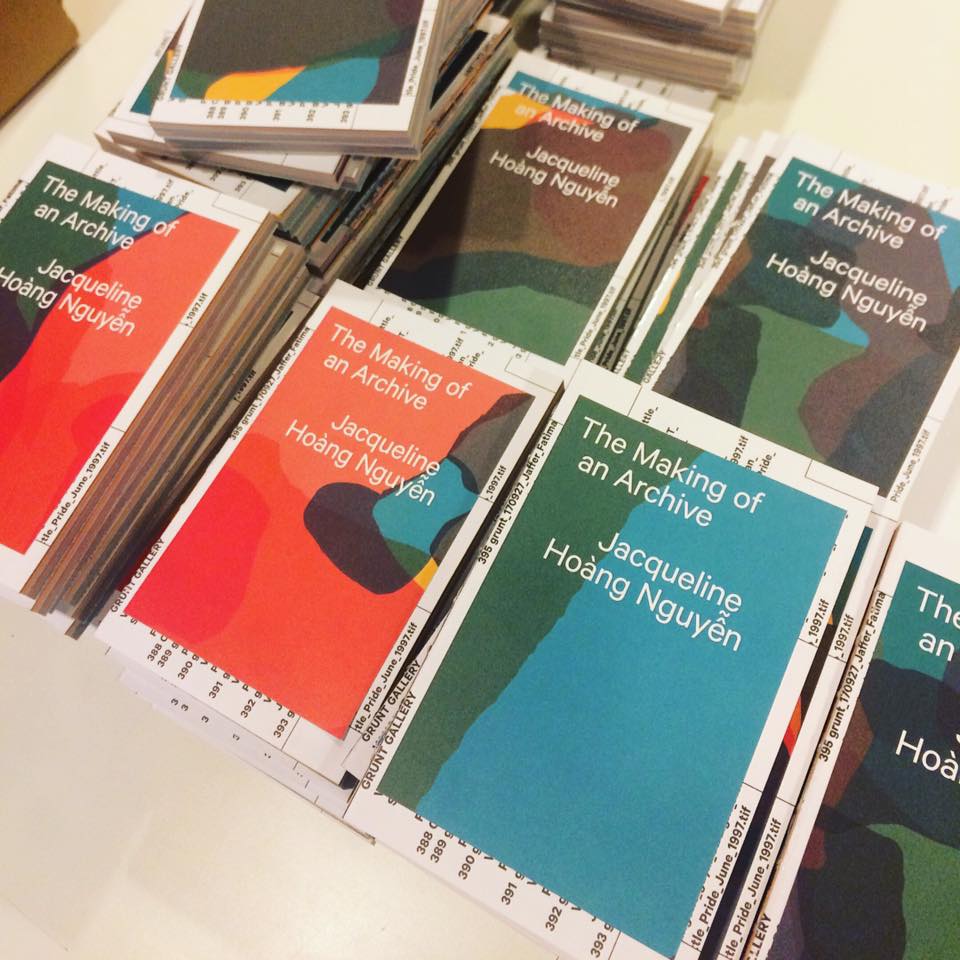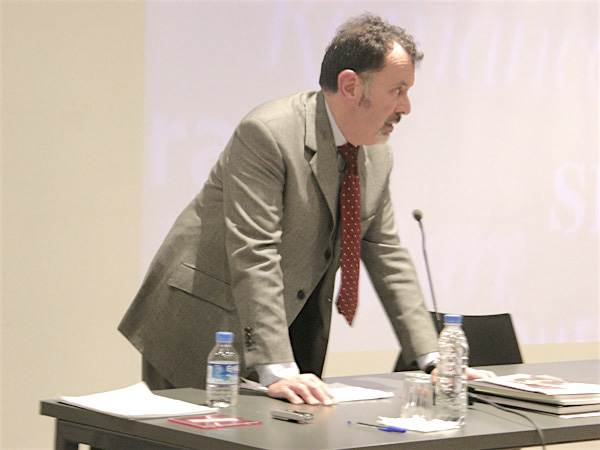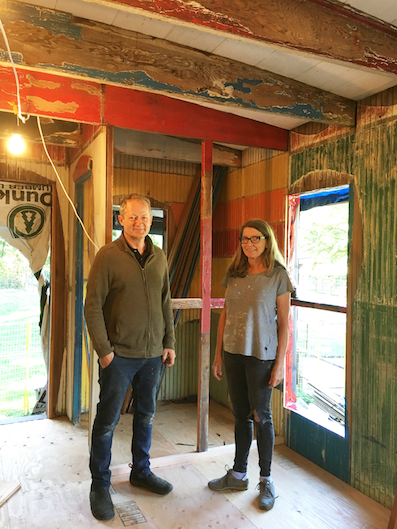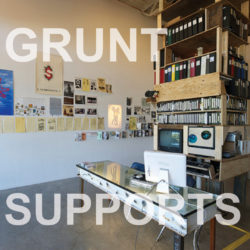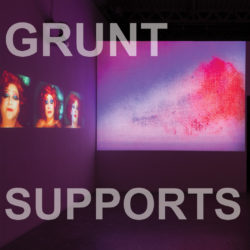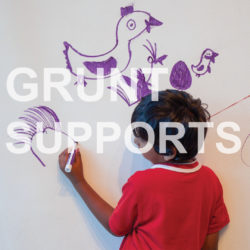The Making of an Archive book is now available for purchase at our bookstore! The book is edited by Jacqueline Hoàng Nguyễn, grunt gallery’s Curator Vanessa Kwan and Archives Manager Dan Pon, with contributions by Liz Park, Gabrielle Moser, Fatima Jaffer, Dan Pon and Tara Robertson, Maiko Tanaka and an introduction by Vanessa Kwan. The publication is designed by Chris Lee.
Submissions
Audio information (from text on page) read by Kay Slater.
The deadline for submissions is July 15th every year. Artists and curators: submit proposals by completing this form.
If Google Forms are not accessible to you, you can submit your proposal by mail or by email to submissions@grunt.ca (Max. attachment size 25MB, you may send multiple emails if necessary; we recommend zip files, or using WeTransfer or Dropbox but please ensure to send us a note that you are doing so). You can also send us your application as a video, maximum 10 minutes in length.
A plain text worksheet with submission questions is available here.
If you have any questions…ask! Reach us via submissions@grunt.ca
Submission information and questions in ASL – video does not contain voice.
All submissions must include the following:
- Your name, address, email, and any other contact information.
- C.V. including a list of any past exhibitions.
- A detailed proposal for the exhibition, describing what you wish to do and any special requirements. You may propose works/projects that are currently in-progress, but please describe the anticipated final outcome.
- Artist Statement.
- Required Question: What is your relationship to making and/or presenting art on stolen land? grunt gallery is located on the unceded and ancestral territories of the xʷməθkʷəy̓əm (Musqueam), Skwxwú7mesh (Squamish) and səlilwətaɬ/selilwitulh (Tsleil-Waututh) Nations, who have lived in kinship with this land, water and air for thousands of years. Applicants from the Musqueam, Squamish and Tsleil-Waututh Nations are not required to answer this and may simply indicate that they belong to a Host Nation.
- Required Question: If your proposal is selected to be presented by grunt, what would you want to learn, practice or try that would provide more points of access to your work? Please feel free to familiarize yourself with grunt’s accessibility practices by exploring content on our website.
- Support materials/Examples of past work (images and/or videos). *Please see notes below.
- Visual art support materials: 5-10 images at 72 dpi minimum. Clearly identified: numbered and including a name, title, dimensions and a numbered image list. Example of title for digital images: 01. Artist Name, Title of work, size of work.jpeg (or other file formats). Please indicate if your submission includes works you do not plan to show with your proposed exhibition.
- Performance art support materials: a short video that typifies and helps to explain your work. Please submit a video file (.m4v, .avi, .mov, etc) or links to online video, not a DVD.
- *if a mailed application only: a self-addressed, stamped envelope to return your submission. Please allow 4 months for consideration. The gallery retains accepted submissions until the exhibition.
View the grunt gallery floor plan here.
Click here for a video walk-through of grunt gallery with audio description.
About the submissions process:
grunt gallery’s programming includes visual and media art exhibitions, installations, screenings, performances and projects, which are often accompanied by print or web publications. We produce gallery-based exhibitions, as well as real-time events and web projects. A curatorial committee of 5-9 people consisting of curators, programming staff, board members and artists meets for 5 days every August to review submissions.
Exhibitions typically run for 6 weeks, with opening receptions held on Thursday or Friday nights. Performances, screenings and talks are also coordinated independently or in conjunction with the exhibitions, held either in-person or online.
Frequently Asked Questions
Q: How many submissions are typically received in a year?
A: This of course varies, but in recent years we have seen an incredible increase in the volume of submissions received and are averaging around 200-230 per year.
Q: How many proposals are selected?
A: There is often some variation in our programming, but typically we select 3 or 4 proposals per year from our submissions jury.
Q: Do you accept international submissions?
A: Yes, but we cannot guarantee funds for travel. However, this has often been the case with our gallery and we are able to and familiar with supporting artists applying for travel grants.
Q: Who is on the grunt exhibitions jury?
A: Our jury is open to all staff, with most participating. We often also invite a guest juror from outside of the organization, but who is also from within the local arts community.
Q: How are exhibition submissions scored?
A: We score in three categories:
Artistic Merit (x/40)
- This score reflects the actual art and ideas expressed in your proposal. Things we are looking for here are how you are contextualizing your work and ideas, and how you see your work engaging with the wider community of artists working in similar fields and mediums. We are also here looking at the craftsmanship and quality of your pieces.
Impact (x/30)
- Impact refers to several things; what kind of impact will it have in our programming and on our audiences but also what kind of impact it will have on the artist at this stage in their career.
Feasibility (x/30)
- There are several factors considered in feasibility including practical considerations like installation, physical space, volume, accessibility, shipping and insurance expenses, but this also includes considerations towards if the gallery feels like we can carry the work with nuance and care.
Regarding content, typically the feasibility score will come into discussion around work that might require trigger warnings due to either the graphic nature of content or if the subject matter is particularly sensitive. This could include things like sexual, domestic and/or physical violence and abuse, representations of medical procedures and/or trauma, residential school, depictions of war and/or genocide and so on. grunt is not opposed to showing works around these subjects, but we are very careful in thinking through how to best hold the artist, the work, ourselves and our audiences.
Q: What does accessibility mean at grunt and what considerations are we looking for in our submission form?
A: Accessibility at grunt means more than just the physical space of the gallery that we are inviting people into. Accessibility is most heavily looked at in the feasibility score, but we also take it into consideration in the artistic merit score; what ideas do you have about creating more access points to your work? If the focus of your work is exploring accessibility and Disability arts, how are you engaging with that conversation? Are you adding to it or critiquing it? How are you acknowledging and holding space for conflicting access needs? Are you prepared for your work to be viewed in our low-sensory & voice off Thursdays?
We understand that not everyone shares the same experiences in engaging with accessibility work, but we always appreciate when it is prioritized or a willingness to collaborate with our Curator and Exhibitions & Accessibility Manager is demonstrated. Even if you’re not sure where or how to start with this work.
Q: What is the budget for each exhibition at grunt gallery?
A: Each exhibition at grunt has a budget of $8500 CAD. A typical budget for an artist submitted exhibition (not submitted by a curator) looks like this:
|
Artist Fee (solo) |
3,300.00* |
|
Shipping (one-way) |
500.00 |
|
Artist Talk/Workshop Fee |
520.00* |
|
Installation Expenses |
580.00 |
|
Guest Writer |
1000.00 |
|
Publication Design |
700.00 |
|
Publication Printing |
1200.00 |
|
Documentation |
500.00 |
|
Hospitality/Other |
200.00 |
*CARFAC 2025 rates
Please note that grunt gallery does not pay for the fabrication of artworks, framing, or material costs. If your project requires further resources than outlined here, please detail all expenses in your proposal.
Q: Does grunt gallery pay for shipping?
A: Shipping is included for one-way and something that is an important consideration in scoring the applications we receive (feasibility score). If there is room in the budget after discussing with the artists, we can sometimes pay for shipping both ways.
Q: Does grunt gallery pay for travel for artists outside of Vancouver?
A: Travel is not promised as a part of exhibiting an artist’s work unfortunately. This is discussed with artists after they’ve been selected and if additional funding cannot be secured or there is no interest in creating a publication, grunt gallery will forgo the exhibition publication and reallocate those funds towards travel.
Q: What if I want to do something outside of the standard exhibition budget?
A: In nearly every case, expanded programming requires seeking additional funding, or for the artist/curator to bring their own funds into the exhibition via artists grants or funding from their institution.
However, this does not mean that we are asking for free work if those other avenues of funding aren’t successful! We know it’s exciting to plan an exhibition and sometimes it’s hard to make sure every aspect of your work is coming across as envisioned, but we always prefer to do something as well as we can with the budget we have, rather than overextending ourselves and the artists.
Q: Can grunt offer support in seeking alternative funding sources?
A: Yes, the Curator and Program Director often work with artists in applying for additional funding. This can come in the form of research to see what’s available, support in the writing of the grant itself and in providing support letters. However, it is important to bear in mind that we still need to have a solid plan with the budget we have in the event that securing those additional funding sources is not successful.
Q: Can I suspend work from the ceiling?
A: Yes and no; we cannot suspend work from the ceiling without also renting scaffolding. Renting scaffolding immediately adds an additional $500-1000 to installation expenses, so if we can find an alternative that is very much preferred so that the remainder of the budget can be allocated to either travel or programming.
Weight is also a consideration; our ceiling is not flat and not easy to add fixtures into.
Q: Why are you asking about our relationship to making and/or presenting art on stolen land on the submission form?
A: Frankly, because this is an important consideration to make for any settler regardless of whether or not they have a show with us. Though grunt gallery’s current Curator is Indigenous, it is still largely and historically has been a settler-run organization. How we, and the artists and collaborators we bring in, are in relation to the land is something we take very seriously. This question is not intended to shift the focus of your project to answering or solving the questions of decolonization and/or reconciliation, but to help us understand how you think of yourself and your practice in relation to these territories. Your responses to this question are for internal review only.
Q: Why are only xʷməθkʷəy̓əm (Musqueam), Skwxwú7mesh (Squamish) and səlilwətaɬ/selilwitulh (Tsleil-Waututh) applicants exempt from this question about making and presenting work on these territories?
A: Because it’s their land and they don’t have to explain themselves to us. If any MST applicants would find this section a useful place to expand their thoughts on how their practice relates to their territories, they are welcome to but it is entirely optional.
Q: If I’m Indigenous but not from MST Host Nations, do I still have to answer this section?
A: Yes, please. Though these answers are for internal review, the Curator is looking for insight into your practice from the moment they begin reviewing submissions.
Documentation:
The gallery documents all exhibitions for our archives digitally. Artists will receive digital copies of these images. Documentation may include installation shots but may not include shots of individual pieces. Artists are free to document individual elements of the exhibition themselves. Performance documentation usually consists of digital photographs and/or video.
Publicity:
Publicity is the responsibility of grunt gallery, and typically includes local event listings, brochures, press releases and information on the grunt website. We will also promote the exhibition through our social media channels. grunt is not responsible for approaching reviewers but will assist whenever possible. Interview requests with journalists will be arranged by the Communications Manager.
For submissions to the Mount Pleasant Community Art Screen:
We accept a wide variety of media works and formats to a maximum of 10 minutes, including video, film, animation, gif and photography, for our urban art screen located on the Independent Building at Kingsway and Broadway in Vancouver. Submissions to the MPCAS are a separate process from our exhibitions submissions.
All MPCAS submission details and forms are here.
Projects
CURRENT PROJECTS:
Mount Pleasant Community Arts Screen
grunt gallery’s Mount Pleasant Community Art Screen (MPCAS) is an outdoor 4×7 metre LED screen featuring art-only content by and for the Mount Pleasant community, located at Kingsway & Broadway in Vancouver on the east side of the Independent building. Visit mpcas.ca for full details!
The Blue Cabin Floating Artist Residency
In 2015, two celebrated Canadian artists, the late Al Neil and his partner, Carole Itter, were evicted from their studio home, a small cabin that had been sitting in a secluded cove on the Tsleil-Waututh territory foreshore near Cates Park since 1932. Over the course of 4 years, a consortium of arts organizations came together to save the cabin and transform it into The Blue Cabin Floating Artist Residency. The Blue Cabin floated into Vancouver’s False Creek in the summer of 2019. In fall 2019, the Blue Cabin Floating Artist Residency launched Skeins: Weaving on the Foreshore, the inaugural program of artist residencies, open houses, talks and workshops. Situated in the unceded lands and waters of the xwməθkwəy̓əm (Musqueam), Skwxwú7mesh (Squamish) and Səl̓ílwətaʔ/Selilwitulh (Tsleil-Waututh) Nations, the Blue Cabin is international in scope but deeply rooted in the histories and narratives of this place, offering a unique opportunity to learn, explore and engage with the foreshore.
Accessible, Exhibitions, Public Programming and Events project (AEPE)
grunt’s Accessible, Exhibitions, Public Programming and Events project (AEPE) supports a radical development prototype, exploring access and accessible planning, community care and public programming, Disability Justice and non-hierarchical approaches to knowledge sharing and decision making. The cross departmental initiative provides leadership and labour to the grunt team as we explore access, justice, and care as an artist-run centre. The AEPE project is led by grunt’s Exhibitions and Accessibility Manager, Kay Slater, and our Accessibility and Events Manager, Keimi Nakashima-Ochoa, alongside the work of grunt’s accessibility committee which is composed of grunt staff across departments and is informed by the vision and priorities of the AEPE project.
Cree & D by These Ones
Cree & D is a narrative podcast that uses the format of Dungeons and Dragons gameplay but reimagined as a Cree-based and focused campaign written by siblings Jessica and Ben Johns. This campaign follows the story of three cuzzins, Auntie Vera, Auntie Darlene and Auntie Mac as they search for Kokum Cardinal’s stolen staff and work to preserve the peace in the realm of Ministik. Cree & D is produced by These Ones (formerly known as Together Apart) and supported by grunt gallery on the unceded territories of the Musqueam, Squamish and Tsleil-Waututh peoples. We record on Treaty 6 at FAVA studios. Art by Abbey Riddle. Music by Matthew Cardinal. Voices by Ben and Jessica with Emily Riddle and Matt Ward.
Digital Stories
grunt gallery and EastVan Digital Stories join forces with Mount Pleasant and Vancouver residents who wish to create short videos around the theme of PLACE. Artists Lorna Boschman and Sebnem Ozpeta host free workshops at grunt gallery that walk participants through the process of digital story making!
PAST PROJECTS:
Spark: Fireside Artist Talk Series
January 2016 – March 2022
A series of informal artist talks hosted by the Native Education College (NEC) in partnership with grunt gallery. These informal talks featured Indigenous artists whose work spans media from the two-dimensional to live performance and beyond. Their works fuse traditional cultural knowledge with contemporary art forms, pose urgent political questions, and push the boundaries of how we think about art, history and culture more broadly.
Recollective: Vancouver Independent Archives Week
A series of free public events, panels, conversations, performances, and screenings that highlight artist-run centre archives, artists working with archives, and the intersections between contemporary art practices and social movements in Vancouver and beyond. Partners: 221a, Artspeak, The Morris and Helen Belkin Art Gallery, Rungh Magazine, VIVO Media Arts Centre, and Western Front.
Nu chexw kw’átchnexw kwétsi sḵel̓áw̓?// Can you See Beaver?
Nu chexw kw’átchnexw kwétsi sḵel̓áw̓?// Can you See Beaver? was a community-based research and public art project led by Gitksan Witsuwit’en artist and community organizer Jolene Andrew and produced by grunt gallery Project Curator Nellie Lamb, in collaboration with Mount Pleasant Neighbourhood House. Visit canyouseebeaver.ca for full details!
These Ones
These Ones (formerly Together Apart) was envisioned as a way of making and holding space for 2SQ/Indigiqueer folks to come together and to be in dialogue with one another so that we might centre the conversations we’d like to hear or that we feel have been absent in our communities. However, our intentions were also simple: to celebrate and enjoy one another’s creativity and dedication to our practices, and to recognize one another in such a way that speaks across the distances we experience in our living and movement through our worlds.
2019
Wordless – The Performance Art of Rebecca Belmore
A beautiful new print publication examining the performance work of Canadian artist Rebecca Belmore, that brings together documentation of Belmore’s 30-year career, as well as generating a series of new work based on her past performance. This project feeds into grunt’s long-term interest in performance art, archives and support of Rebecca Belmore’s work. This project also included an exhibition of new photographs by Belmore, nindinawemaganidog (all of my relations), and the re-deisgn of Belmore’s website. Wordless: The Performance Art of Rebecca Belmore is now available via our online bookstore.
Particles: Seoul to Vancouver
Particles continues grunt’s partnership with organizations and artists in Seoul, South Korea. This international program began in Seoul in 2018 with Instant Coffee’s project Pink Noise Pop Up and continues with an artist residency, an exhibition and a curatorial tour in Vancouver this May. Event information is below.
2018
Pink Noise Pop Up
March – April 2018
A series of events that expands the relationship between the arts communities in Vancouver and Seoul, Pink Noise Pop Up seeks to highlight the ways that art interacts with the often complex social and economic conditions of the city. Based in the work of Canadian arts collective Instant Coffee, this exhibition includes installations, artist editions, performances and other collaborations that will take place in South Korea.
The Making of An Archive
Summer 2017 – Spring 2018
Jacqueline Hoàng Nguyễn’s project, The Making of an Archive, seeks to collect images of everyday life photographed by Canadian immigrants, in a direct, collective and exploratory approach.
2017
Journey to Kaho’olawe
May 25 – 30, 2017
Journey to Kaho’olawe is an artist publication by Hans Winkler and T’uy’t-tanat Cease Wyss. The book is the result of a four year process centred on the Hawaiian Island of Kaho’olawe, a sacred site to the Hawaiians in recovery after being occupied as a practice range by the American military. Returned to the Hawaiians in the 1990s, the island is being remediated and returned to its natural state. In conjunction with the launch of the publication grunt gallery and the artists present a week long series of events celebrating Kaho’olawe and the Kanaka presence in BC.
Spring Fever: Vancouver Independent Archives 2017
March 18 – April 8, 2017
This spring season, Vancouver Independent Archives will offer a series of free public talks, screenings and community workshops that foreground local art and art history by drawing on the archives of Vancouver’s independent arts community. Building on the success of Vancouver Independent Archives Week 2015, Spring Fever invites new partner artists, scholars, and organizations to share their approach toward and practice within the archive.
Intertextual
What’s At Stake? Intertextual Indigenous Knowledges is an afternoon of talks, panels and a spoken word performance which examines knowledge, power, authority, and sovereignty in the construction of artistic practices. The event follows from Intertextual: Art in Dialogue, a roving reading group that was held at participating galleries over the last year.
2016
Shako Club
A series of workshops in the Tonari Gumi kitchen and studio space around concepts of wellness, care and food where culinary “sculptures” were constructed, incorporating aspects of stories, ideas and wellness philosophies. By artist Cindy Mochizuki and members from Tonari Gumi.
Past and Presence: NEC Mural Project
The Native Education College and grunt gallery are partnering with Vancouver-based First Nations artists Corey Bulpitt, Sharifah Marsden and Jerry Whitehead to create a mural celebrating NEC’s 30 years in Mount Pleasant.
Cutting Copper: Indigenous Resurgent Practice
A collaborative project between grunt gallery and the Belkin Art Gallery, aiming to bring together a cross-disciplinary group of artists, curators, writers, educators, scholars, students, and activists to explore the embodied theory of Indigenous resurgence and cultural representation – both from the perspectives of their own disciplines and one another’s.
2015
Terminus: Archives, Ephemera, and Electronic Art
This workshop was a part of the 2015 International Symposium on Electronic Art (ISEA). Organized by the Ethnographic Terminalia Collective in collaboration with Tarah Hogue and Glenn Alteen.
FutureLoss
Space, on Main Street and in Vancouver, is currency, and artist Zoe Kreye’s practice reaches through the overarching narratives of real estate, gentrification and speculation to consider the poetics of an individual’s connection to place.
2014
MAINSTREETERS: Taking Advantage, 1972–1982
The history of a gang of Vancouver artists who lived and worked together in drama, excess, friendship and grief.
30th Anniversary
Thirty years is a long time. A retrospective of all that is (and was) grunt gallery.
Play, Fall, Rest, Dance
The artist works with children with disabilities to emphasize the state of making and being, the pursuit of uninhibited creative exploration that is void of rules, structures and concepts of ‘right or wrong’ and ‘perfection vs. mistakes’. Children are enabled with artistic autonomy and the artist thoughtfully guides them to explore their creative processes. By artist Valerie Salez.
gruntCraft
A youth engagement pilot program developed to bridge the creative work being done by youth in the popular online video game Minecraft and artistic inquiry at grunt gallery.
2013
ThisPlace Vancouver
Rethinking ideas about Vancouver’s identity and history, this project attempted to compile a collaborative archive in order to expand the collective awareness of the city’s narratives.
2009
Vancouver Art in the Sixties: Ruins in Process
A digital archive of artwork, ephemera, and film.
2008
Nikamon Ohci Askiy (songs because of the land)
In December 2008, artist Cheryl L’Hirondelle made daily journeys throughout Vancouver and “sung” the landscape she encountered.
Beat Nation
Hip Hop as Indigenous culture.
The Medicine Project
Aboriginal notions of medicine and how they influence the lives of First Nations people and artists today.
2006
First Vision
Two worlds – curated by Tania Willard.
2005 – 2009
Brunt Magazine
Showcasing the artists exhibited at grunt gallery, brunt magazine is a complement to the exhibitions and a closer look at the artists, their processes, and the ideas that inspire their work.
BLOG: Beyond basic, base and a little repugnant: the evolution of grunt gallery
Please enjoy this deep, but short chat between Director/Curator Glenn Aleen (GA) and Curator Vanessa Kwan (VK) presented in short form.
For our first blog, we thought it was crucial to set up the site lines for both the beginning of grunt and where it currently stands today. These views are differently expressed through two generations of curatorial practice here at our artist-run centre and are the focus of this back and forth email conversation between our two curators.
VK: I think this is a nice opportunity to talk about the curatorial priorities/ thoughts about grunt, and how it has evolved and continues to evolve. Maybe that’s a good place to start.
First question: Every time I introduce to a tour group or someone who has never visited the gallery before, I always start with the historical details: the gallery was founded in 1984, and the impetus at that time was to be a place for artists who were not, for whatever reason, being shown or recognized in Vancouver. This led to an emphasis on many practices and subjectivities being represented here – many from traditionally marginalized communities; artists of colour, queer artists, Indigenous artists and performance artists all found a place to show their work and build community. Does this work with your own thoughts/recollections of those foundational years?
VK: And as a follow-up question – how do you see this mandate having evolved?
GA: I understand the introduction we give but these days it often gets read solely through the lens of identity politics which doesn’t really tell the whole story. Not to say that identity politics wasn’t there at the time, it was, but it also included other marginal practices that get left by the wayside in the retelling sometimes. The art scene was a lot more siloed then in all kinds of ways and galleries and artist centres fit inside of these silos in ways that don’t happen so much now or at least not like that. And that marginality back then wasn’t just Indigenous, queer, feminist, or POC artists’ communities but included outsider artists, graffiti artists, comic artists, performance artists, etc. Also, contemporary artists doing serious work in ceramics or printmaking or textile work. grunt was really about breaking down the silos or working across them in many ways. I guess intersectional really–though that word wasn’t used at the time. Because of this plurality, people had a hard time categorizing what we were doing because it didn’t fit any of the reductive lenses they were looking at us through. They thought of us as all over the place, scattered and maybe a bit unfocused. In hindsight, I think that was really the point, but it took a while before some people got it.
The nature of the community that got created was really based in diversity. You knew going to grunt that you would have conversations with people who weren’t like you and see art that wasn’t like yours. The people who felt the most comfortable were the ones who didn’t feel that comfortable anywhere else. It was a community of loners in many ways. I remember Aiyyana Maracle saying after she made her transition that without grunt it would have been a much harder experience. It was the one place she felt normal and nobody was judging her.
How did the mandate evolve? I think mostly in response to the art world itself. It changed and we changed in response. In the 1990s few galleries would show Indigenous contemporary art. There were places to show if you were doing traditional work but it was much harder for contemporary work. Especially if you were an emerging artist. So, many would apply at grunt because they had so few other choices and we had to respond. You would show one and six more would apply. This is no longer the situation. Indigenous emerging artists are everywhere now – as they should be. As you know the last part of our curatorial process is asking if we didn’t show a certain artist or body of work would it get shown in Vancouver? That question we have been asking since the beginning but the nature of what work fits that category is always changing. But it wasn’t just oppositional though. I think grunt’s success is that the larger art world recognizes how important that mandate has been to a healthier art community.
In your court!
VK: I like this clarification of how things took shape in the early years. I think my tendency is to put a lens on what grunt did back then so it aligns with a particular cultural or political context, but you’re right – it was about a true (and uncategorizable) diversity of forms and personalities coming together. Paul Wong once said to me that he thought grunt was the “gangly nerd” of the Vancouver arts community, and that phrase has stuck with me ever since – maybe because the idea of a nerd is that there’s a weirdness there that resists a clear picture of what the future holds: the archetype (can you say a nerd is archetypal??) of the nerd is that they grow up to be something you probably didn’t expect, and possibly underestimated.
Now we say in our “About” blurb that grunt focusses on practices “that challenge and problematize existing hierarchies of cultural value” which is another way of saying we try to remain responsive to what’s happening culturally. I really appreciate this aspect of how grunt works. I think it’s typical in the art world to look at what has currency and try to get ahead of that curve (it is a speculative market economy after all) and I would say grunt has another kind of investment philosophy. You and I have talked a bit about non-proprietary approaches to cultural capital, and also about what it might mean to disseminate rather than accrue resources. This is ranging dangerously close to navel-gazing, but I wonder what you think about capital and how it has been disseminated over the years through the gallery and what it does. I say this knowing that grunt has also engaged wholeheartedly in financial capital expansion (we own the space we’re in, we have worked and continue to work with for-profit developers to gain stability, etc), and it’s important to be clear that a flexible approach to cultural capital comes from the privileges of having a sustainable place to be and operate.
And then, with all this in mind, how do you see the new things on the horizon playing into these ideas? The Blue Cabin, the Mount Pleasant Community Art Screen are all big new projects for grunt, and represent unknown directions for the gallery. How do you think these new projects will expand or evolve our mandate? Will they?
GA: Paul is right we were the gangly nerd on the scene and in some ways we still are. We certainly weren’t hip or happening or trying to be. The real reason we called it grunt was because it wasn’t cool or clever. It was basic, base and a little repugnant. And despite the fact there was incredible diversity among us in hindsight it wasn’t very politically correct back then; people didn’t watch their tongues and got called out on it all the time. That said in hindsight, also those were gentler times before social media and there was a sense of humour about it that there isn’t now (and I’m not suggesting there should be now!). But in that flux, a lot of things could happen and did. So instead of a highly negotiated space, it was more like a barely negotiated space and lots of alliances, friendships, and collaborations emerged, some still continuing. And the clashes weren’t hostile – they were enjoyed for the most part. They took us places no one else was headed. When you throw personalities into the mix things happened. And there were some big personalities all who left their marks. And they formed and informed what we were doing.
I appreciate what you’re saying about our cultural capital approach. It is non-proprietary but that’s only part of it. Our ability to take cultural capital from one place and move it into a different arena is essential to grunt’s history and something it still uniquely does. We have been very successful in taking our credibility in one area and using it to open up opportunities in a completely unrelated area where frankly we should have no credibility at all. This plays out in all kinds of ways. One of the reasons we were able to purchase our space 20 years ago was we had done the Mount Pleasant Community Fence the year before and worked pretty much with the entire community, so we had incredible word-of-mouth in the community at that moment. That paid out directly with the development company we eventually worked within a marketing deal that enabled us to purchase the space. They were looking for the community credibility we had, but it was definitely a big part of that project. The year before it probably wouldn’t have worked. Recognizing that opportunity was a big part of it though.
Those shifts have been essential to our growth. I notice we change modes every 6 or 7 years. In 1999 we started LIVE and left it in 2005, We spent the next six years producing websites and then in 2011 started into grunt archives. Now in 2018, we are taking on Residencies and the Urban Screen. Again though, we are using our credibility in certain areas to move into other areas. It always means we are moving into areas where we have no expertise and we need to learn new skills and best practices. In many ways, the work we have done in the last few years around institutional structures and how we look at them has made us more resilient and able to take on these challenges, but it’s still a tall order. But we were ready to expand. We paid off our mortgage so had very cheap facility costs so The Blue Cabin didn’t look so onerous. It’s an exciting project that mixes cultural production and heritage in ways we haven’t seen before and I think it will open up space for artists and create a unique public monument. The Mount Pleasant Community Art Screen was really more opportunistic. We were offered an urban screen to program media art and in many ways to take it at face value would have been problematic. By turning the curatorial focus for the screen on the community we have an opportunity to take this to places urban screens have never really gone before.
What ties our work together, though, is working out of a sense of a larger community, and that word “community” has evolved in meaning over the past 35 years. Along with collaboration, these two really have been present through all the stages. Also what has evolved, I think, is grunt understands its role in the ecology now more then we did at the beginning, how we fit in and what we need to do. Will these projects live up to their potential or our vision for them? I hope so, but they are both important to do even if we fall flat on our faces. What they become will be interesting to watch and develop. I think looking for successes and failures is not as interesting as watching the paths they will take us on. The work is the reward. I’m not sure they expand our mandate as much as evolve it. They will definitely give artists opportunities they never had before. That’s always good. ⃢
Please come back for the next blog to be released soon at grunt.ca
The Making of an Archive
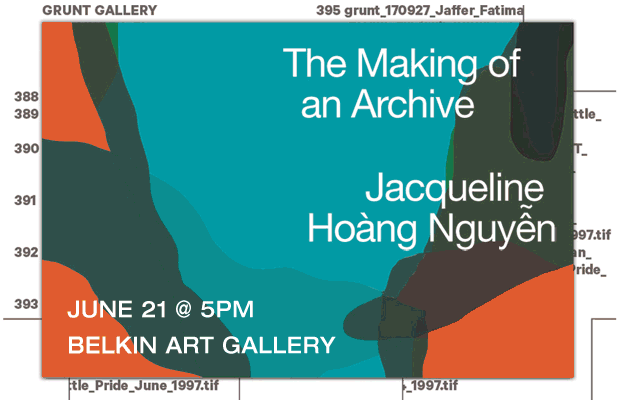
Jacqueline Hoàng Nguyễn’s The Making of an Archive is a project that seeks to collect images of everyday life photographed by Canadian immigrants, in a direct, collective and exploratory approach.
The Making of an Archive
Book Launch and Artist Talk with Jacqueline Hoàng Nguyễn
A collaboration with grunt gallery
Thursday, June 21, 2018 at 5 PM
In collaboration with grunt gallery and in conjunction with the opening reception for Beginning with the Seventies: Radial Change, the Belkin is pleased to present a book launch and artist talk with Jacqueline Hoàng Nguyễn. The main catalyst for the initiation of Jacqueline Hoàng Nguyễn’s project The Making of an Archive was the photo albums of the artist’s father, an amateur photographer who took countless photographs of his daily life when he first immigrated to Canada in the 1970s. However, while doing research for previous works, the lack of representation of the immigrant’s daily life in state narratives seemed paradoxical for a country that is internationally known as the instigator of multiculturalism. Due to this visual deficiency and threat of photographic disintegration, Nguyễn initiated The Making of an Archive, a project that seeks to collect images of everyday life photographed by migrants, particularly of people of colour, in a direct, collective and exploratory approach. One of the salient themes of the work is how to make visible the rich histories of activism and solidarity that complicate the pervasive myth of the agreeable “model minority.” The publication The Making of an Archive serves as a critical document of Nguyễn’s research and the project’s relevance to larger conversations around Canadian vernacular photography by people of colour, the role of the artist-initiated archive, and how an expansion of the archival record relates to political and social change. As part of the book launch, the artist will ask, what is the process of building a collective archive and how do we come to understand our own pictures, together?
Jacqueline Hoàng Nguyễn is a research-based artist and uses a broad range of media, often relying on archival material to investigate issues of historicity, collectivity, Utopian politics and multiculturalism within the framework of feminist theory. Currently based in Stockholm, she completed the Whitney’s Independent Study Program, New York, in 2011, having obtained her MFA and a post-graduate diploma in Critical Studies from the Malmö Art Academy, Sweden, in 2005, and a BFA from Concordia University, Montreal, in 2003. Nguyễn’s work has been shown internationally in institutions including SAVVY, Berlin (2017); EFA Project Space, New York (2016); Mercer Union, Toronto (2015); MTL BNL at the Musée d’Art Contemporain, Montreal (2014); Kunstverein Braunschweig, Germany (2013); Apexart, New York (2013); and the Institute of Contemporary Art, Philadelphia (2011). She has also been awarded a number of grants for her research-based practice from the Canada Council for the Arts; The Banff Centre’s Brenda and Jamie Mackie Fellowship for Visual Artists; and The Swedish Arts Grants Committee’s International Program for Visual Arts. Nguyễn was the 2017 Audain Visual Artist In Residence at Simon Fraser University in Vancouver and participated in the fourth cycle of NTU Center for Contemporary Art Singapore’s Residencies Program. In 2018, Nguyễn was nominated as one of the five finalists for the third MNBAQ Contemporary Art Award by The Musée national des beaux-arts du Québec.
The Making of an Archive is edited by Jacqueline Hoàng Nguyễn, grunt gallery’s Curator Vanessa Kwan and Archives Manager Dan Pon, with contributions by Liz Park, Gabrielle Moser, Fatima Jaffer, Dan Pon and Tara Robertson, Maiko Tanaka and an introduction by Vanessa Kwan. The publication is designed by Chris Lee.
—
For more information go to the Belkin Gallery
The Making of an Archive book will be available in our online book store soon.
—
For further information please contact: Jana Tyner at jana.tyner@ubc.ca,
tel: (604) 822-1389, or fax: (604) 822-6689
Nuova Icona Director, Dr Vittorio Urbani, in conversation with Director Glenn Alteen
Glenn Alteen, Director of grunt gallery, in conversation with Vittorio Urbani, Nuova Icona Director. The talk will take place at the Italian Cultural Centre on Tuesday, October 17 at 7 pm. (more…)
Blue Cabin Artist Talk
Leave a commentGRUNT SUPPORTS _______.
Leave a commentThe Making of an Archive: FAQ
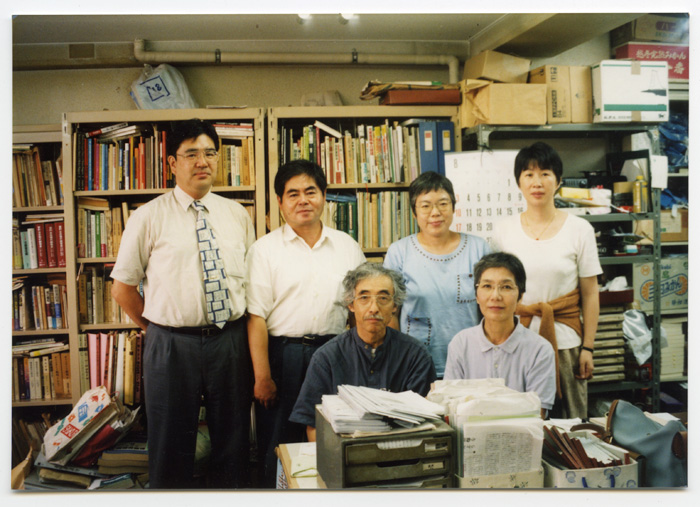
Are you or your family an immigrant to Canada? Are you interested in being a part of a growing archive of community history? Do you have family photos you would like to digitize? Please consider taking part in The Making of an Archive, a project initiated by artist Jacqueline Hoàng Nguyễn and presented by grunt gallery (Vancouver) and Gendai Gallery (Toronto).
What
We are inviting contribution of photographs (slides or prints) of your family’s experience of immigration in Canada. We are most interested in personal collections – those images that taken within families and communities by friends/relatives with personal connections to the subjects.
How
The archives at grunt gallery are equipped with digitization and storage capabilities, and we are inviting members of the public (you!) to bring photographs (prints, 35mm, Polaroids, slides or negatives) We give you a digital copy of the images and store a copy in The Making of an Archive collection. The originals are returned to you.
What will happen to my images?
Jacqueline is keeping a repository of this growing archive, and grunt will be maintaining a back up of any images collected via our onsite sessions. The images may at some point be featured online or in print – but only with your written permission.
Some questions that might help:
What images, for you, show how your family + community supported one another?
(This is a very open question – many collections include bbqs, social gatherings, birthday parties, special dinners and so on; all this is relevant!)
Do you have images that show your family engaging publicly with events/ organizing/ volunteering?
(We have gathered some amazing images of people at community meetings, cultural festivals, marches and protests – this is the kind of thing that is really lacking in official archives.)
Are there images outside the scope of the archives?
Studio photography in its stale fashion (think of Sears portrait photography!) is not so much relevant to us. We are interested in life with its struggles, joys, friendships, strangeness and hope.
How many images can I bring?
We will digitize collections from 1 – 100 images (that’s 1 – 2 photo books, generally).
What time commitment is required?
Up to 2 hours, depending on the size of your collection. We collect the images beforehand, digitize them, and then invite you to sit with our volunteers for a short interview while we review the material – where you describe to us what is happening in the images. We record and keep this oral account of the images as part of the archive.
Where can I learn more?
Online:
Via grunt’s website: https://grunt.ca/the-making-of-an-archive/
Via the Making of an Archive Website: https://www.themakingofanarchive.com/ (currently under construction)
Image courtesy Tatsuo Kage
